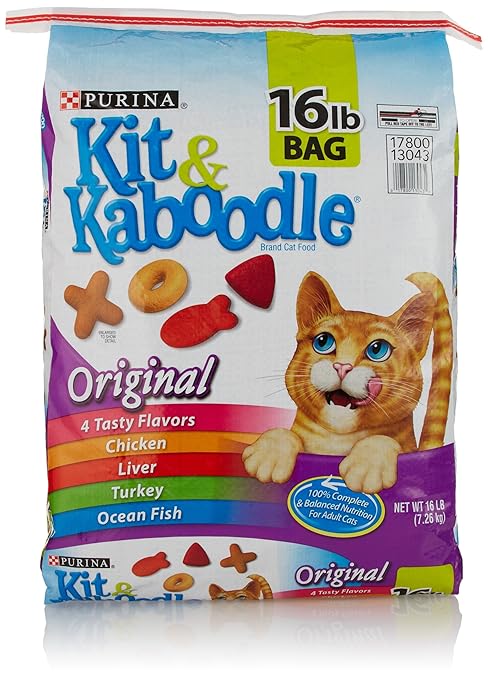(Topic credit: this post was suggested by the discussion on +Kimberly Dalessandro 's post.)
Down in the comment section is an observation, "My dog eats the round red pieces first."
The Cat Sanctuary cats aren't encouraged to be picky eaters--that behavior really comes out in overfed, under-exercised animals, anyway. My cats usually like dry kibble. They like just about all brands and flavors, although I read labels and avoid buying the ones that feature "animal digest" as a main ingredient.
 The package pictured tends to be the cheapest acceptable-quality brand in local stores, so it's a brand the cats often get. (
The package pictured tends to be the cheapest acceptable-quality brand in local stores, so it's a brand the cats often get. (
They nearly always nonverbally express extra appreciation for...a new, fresh batch. They liked the last of the old batch well enough, but a new batch is crisper and yummier. Kitten Chow is supposed to be a little more nutritious than Kit'n'Kaboodle, but I don't know whether the cats are keen on it for that reason or just because it comes in smaller bags.
I have opened just a few cat food items that my cats rejected. There was a box of dry kibble from one of those "salvage grocery stores" that smelled so rancid, even to me, that I was surprised to be able to get some use out of it as mouse bait. There was one batch of canned cat treats that was also quite disgusting when opened; I should probably have returned them to the store, but I used one of the cans to trap a possum. Other than that, there are some flavors of cat food that smell too rank for me, but the cats seem to like them.
Anyway, although all kibble is basically grain meal mixed with some kind of animal fat, manufacturers often claim that they're using different kinds of fat to flavor different kibbles within the package. Sometimes the individual kibbles are shaped to suggest the origin of the fat and flavor. I've never been completely convinced...to a human nose it all smells like kibble, which is not very appealing to human tastes.
I don't know whether the cats notice different flavors in the Kit'n'Kaboodle mix. They show no preference.
Then again, when offered a meal that definitely does contain different flavors, the social cats tend to eat socially. They take a few bites from one dish or tin, then let someone else sample that and take a few bites from another dish. This preference is strong enough that when offered four-packs of identical tins for four adult cats, the cats still rotate among the tins, checking that it's all the same thing in each one...or bonding with each other by sharing, or both.
As +Andria Perry mentioned...
...another factor that makes it hard to identify my cats' food preferences is that they are social eaters. They love anything a friend is eating. When sharing food with one another they give mixed messages--the one who's eating a tin of tuna, a teriyaki chicken strip, or a fresh raw squirrel will growl as if to say "Back off, it's mine," but her/his growling actually functions to attract the other cats, and when the one who's been growling pauses for breath, the others finish the special food without objections.
Of things humans eat, they obviously like meat and fish best...but they'll try anything. Pet cats and dogs usually beg if their humans eat in their presence, not because they especially like the food or can even digest it--some human foods, like chocolate, can make cats and dogs sick--but just because sharing food shows friendship. I've known cats who would make an honest effort to eat lettuce and peanuts. I eat those things; therefore the cats would beg for them, and try not to waste them.
One human food that seems to be good for pets is pumpkin seeds (often sold under their Spanish name, pepitas). These high-protein treats are rich in minerals and toxic to some kinds of intestinal worms. I've seen skinny, wormy-looking cats become sleek and healthy after pumpkinseed meal was added to their Friskies (or 9 Lives, or Chicken of the Sea) for a week. Cats who are unaccustomed to this treat nibble cautiously around it and leave as much as possible in the tin...but cats who've seen their human, or their mother, eating pumpkinseed meal will eat it first, possibly in order to savor the real fish afterward.
Those are my cats' preferences. Do your pets have different preferences?

No comments:
Post a Comment